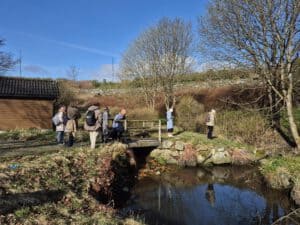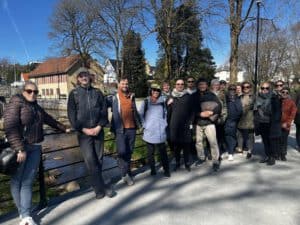
City Blues supports nature and human wellbeing with nature-based solutions
30 April 2025
While mitigating climate change is key to tackling these challenges, it is also important for cities to adapt and prepare for various risks. The sooner we adapt and prepare, the less uncontrolled damage will occur. Therefore, even better integration of climate change adaptation measures and urban storm water management is needed.

Floods will become increasingly common in the future due to climate change.
Cities face similar challenges
City Blues project partner cities from Aarhus, Malmö, Stavanger, Tampere, and Tartu share similar watershed challenges that are also well represented in the wider Baltic Sea region context, such as fluvial (riverine) and pluvial (rainfall) flooding, erosion of the stream banks during high flows, limited capacity in the streams, and pollution from storm water and from surrounding land use.
The City Blue project aims to support adaptation to negative effects of climate change and to improve green and blue infrastructure of densifying cities through integrated nature-based solutions (NBS) for urban flooding and storm water management. NBS are multifunctional and cost-effective measures that address societal challenges by protecting, developing or creating ecosystems while promoting biodiversity and human wellbeing.
The solutions can vary in shapes and sizes, for example, from rain gardens and bioswales to retentions ponds and alluvial meadows. With nature-based watershed management solutions, we can also renature our cities and make them more livable while tackling several challenges with integrated solutions.

City Blues project consortium visited Stavanger and explored the nature-based solutions in the city.
“The project aims to protect and improve the water quality of the receiving lakes and further in the Baltic Sea by reducing water cloudiness, nutrient loading, and wastewater emissions – even during periods of high water flow. At the same time, we can build long-term urban flood and storm water resilience and promote biodiversity in the cities”, says Project Manager Anna Vilhula from the City of Tampere.
Joint operational model as a tool to support cities’ work in NBS
Cities can benefit from sharing knowledge on planning and the long-term functionality of NBS adaptations. Thus, the main outcome of the project is a joint operational model in the form of a website that offers cities’ experts practical information, such as best practices and universally applicable monitoring and maintenance guidelines for NBS. The model will help implement NBS projects across the whole life cycle from planning to designing, maintaining and repurposing. One important viewpoint is also how to involve stakeholders in this work.
“Cities need the NBS model to turn the complexities of storm water management into opportunities for greater urban resilience and liveability. The model provides a practical, lifecycle-based approach to implementing nature-based solutions that are not only effective and cost-efficient at the catchment scale, but also adaptable to diverse urban settings and governance frameworks — helping cities learn from each other’s successes and avoid common pitfalls”, says Expert Murel Truu from Tallinn University of Technology.

City Blues consortium.
The website is designed to harmonise practices between cities. It also provides information to residents on how they can contribute to increasing the use of nature-based solutions in their neighbourhood. The finished site will be published in spring 2026. With the tool, City Blues wants to make the use of NBS and watershed-based thinking mainstream. The Interreg Baltic Sea Region programme plays a crucial role in enabling these efforts and bringing important actors and knowledge partners together.





